SCHUYLERVILLENEW YORK |
 |
SCHUYLERVILLENEW YORK |
 |
Schuyler House – In front of the Schuyler house, there is a marker at the pathway entrance that relates its history. Depending on the time of the year, volunteers in period costume may be on hand to give you a tour of the house. Tours are scheduled on the half-hour.
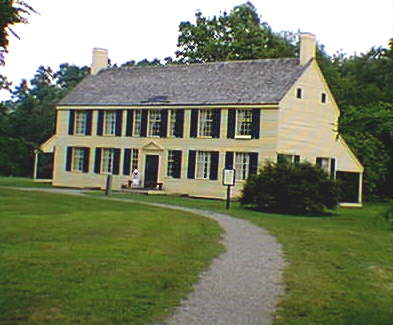
|
|
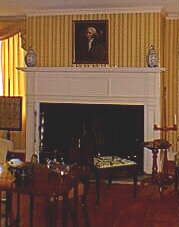
|
Schuyler House "We passed Hudson's River and encamped in the plains of Saratoga at which place there is a handsome and commodious dwelling house," so wrote an officer of British General John Burgoyne's invading army in September 1777. The dwelling house was the country home of wealthy landowner, Philip Schuyler. Less than a month later, his army reeling in defeat, Burgoyne ordered the house burned so the American could not use it for cover. Despite this precaution, the proud Burgoyne was force to surrender his army on October 17, 1777 in a field not far from the smoldering ruins. Within weeks, Schuyler was earnestly engaged in building a house at this place. By the end of November 1777, the present building was completed, possibly built in part on the foundation of the old dwelling house. The present Schuyler House has been carefully restored to its 1787-1804 appearance. |
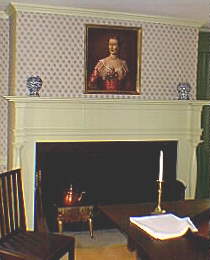 |
|
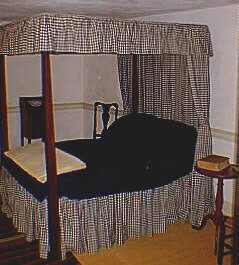 |
|
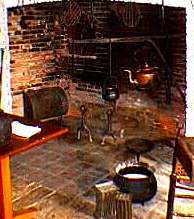 |
|
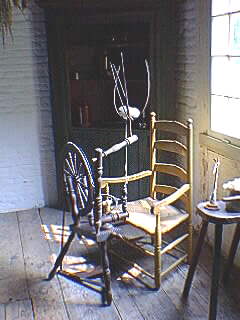 |
|
Just across the Fishkill River bridge on the left is the Schuyler House. Across from the house on the west side of Route 4 is a Schuyler family marker. The marker shows the sacrifice made by the Schuyler family to colonize this area.
|
|
November 28, 1745, on these grounds the French and Indians killed Captain Philip Schuyler and thirty others, burning mills, stores and thirty houses. On June 30, 1747, the garrison of Fort Saratoga was surprised when 45 men were tomahawked and scalped. Site of the house of Captain Schuyler, 1745 and General Philip Schuyler, 1777. |
Revolutionary War Markers in Schuylerville – There are two markers near the bridge across the Fishkill River. One of the two is a Knox Trail marker. The other is about the recovery of a soldier and a horse. There is also a Conventions of Saratoga marker near the center of town.
|
|
Here in 1880 while excavating for the Bullard Paper Mill, the remains of an unknown soldier and his horse were exhumed. |
Saratoga Monument – The monument commemorates the surrender of British Forces to American Forces on October 17, 1777. As explained by the marker in front of the monument, each side of the monument has a niche for each of the major American contributors in the Battles of Saratoga: Philip Schuyler, Daniel Morgan, Horatio Gates and Benedict Arnold. Statues are in each niche, except Arnolds.
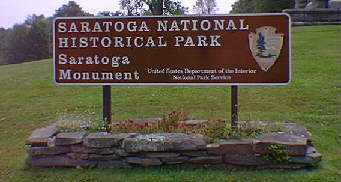 |
|
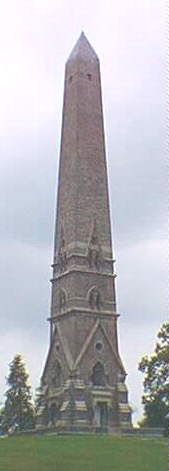 |
Saratoga Monument The Saratoga Monument commemorates the surrender of the British Army under the command of General John Burgoyne to General Horatio Gates commander of the America forces on 17 October 1777 following the battles of Saratoga. The battles and subsequent surrender are considered a turning point in the American Revolution by leading to French support and the hope of ultimate victory. This lofty sight was chosen for the monument because of its commanding view of the surrounding battlefield sites and its historical association with Burgoyne's campaign. The cornerstone was laid on 17 October 1877, one hundred years after the British surrender. The capstone was put into place in 1882 and the decorative elements of bronze statues and interior bass relief was finally completed in 1887. A cast iron stairway lead up 184 steps to an observation deck which is closed. |
A climb to the top of the monument is recommended for the non-acrophobic.
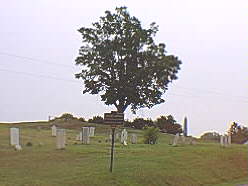 |
Colonel Morgan Colonel Morgan held this position to prevent British retreat to the west. |
Revolutionary War Markers on the North Side of Schuylerville – The first marker is at the position that Daniel Morgan and his riflemen took to stop a possible British retreat to the west. The marker is near a small cemetery where many of the graves date back to the middle 1800's.
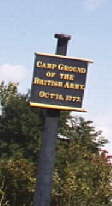 |
Campground of the British Army October 15, 1777. October 15, 1777. |
A series of four markers can be found along Route 29. There are two British encampment markers. One is near a gift shop. The other is in front of a home near the Schuylerville Central School. There is a breastworks marker opposite the school and there is a barracks just before the intersection with US Route 4.
|
Camp of General Burgoyne October 10-17, 1777. |
The Breastworks of Burgoyne |
Continental Barracks Where General Stark tried and condemned the Tory, Lovelass as a spy. |
Fort Hardy Park – In the months prior to October 8, 1777, the British suffered about 2,000 casualties. Burgoyne's forces, now down to about 6,000 men, took refuge in a fortified camp on the heights of Saratoga (today’s Schuylerville). There an American force that was approaching 20,000 men surrounded the exhausted British army.
|
|
On these fields, the British Army grounded arms at the surrender. |
Faced with such overwhelming numbers, Burgoyne surrendered on October 17, 1777. By the terms of the Convention of Saratoga, Burgoyne's depleted army marched out of camp "with the Honors of War" and stacked their weapons along the west bank of the Hudson River at Fort Hardy. Saratoga was a decisive and important victory. It was the turning point of the American Revolution.
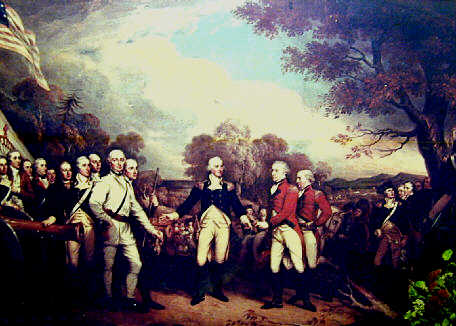
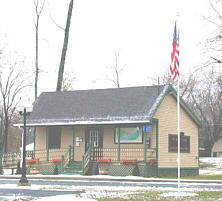 The park is site where the British laid down their arms after
the battles of Saratoga. Today, Fort Hardy is an athletic park with soccer
fields and other athletic facilities. Keeping the history alive on the west side
of the field is the Schuylerville Visitor Center. Inside, there are history
exhibits as well as information about Schuylerville. Near the visitor center is
a marker for the Surrender Tree, under which the surrender documents were
signed. There is also a surrender marker near the entrance to the park.
The park is site where the British laid down their arms after
the battles of Saratoga. Today, Fort Hardy is an athletic park with soccer
fields and other athletic facilities. Keeping the history alive on the west side
of the field is the Schuylerville Visitor Center. Inside, there are history
exhibits as well as information about Schuylerville. Near the visitor center is
a marker for the Surrender Tree, under which the surrender documents were
signed. There is also a surrender marker near the entrance to the park.
The General Philip Schuyler Commemorative Highway.
|
|
Town of Saratoga
Mother town of Saratoga County. First European settlers, 1688. Established, March 7, 1788. Surrender site of General Burgoyne to General Gates, October 17, 1777. (Schuylerville Marker) |
